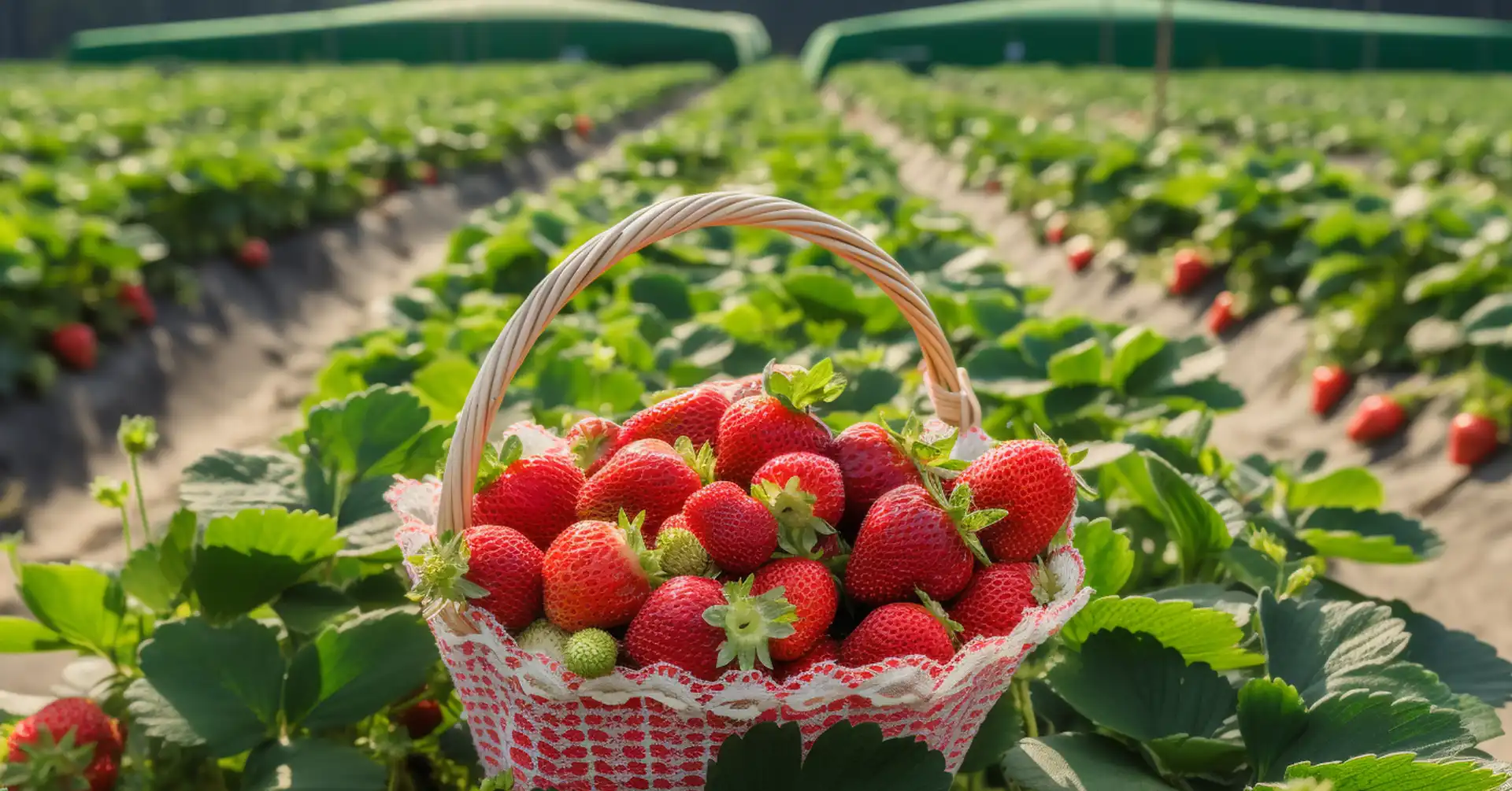When it comes to cultivating strawberries, the DIY Strawberry Planter stands out as a smart and space-efficient solution. In this section, we’ll delve into the essence of this vertical gardening approach, exploring its design and the advantages it brings to strawberry enthusiasts.
DIY Strawberry Planter
The DIY Strawberry Planter is a purposeful creation designed for growing strawberries in a vertical arrangement. Unlike traditional methods, this planter optimizes space, making it a great fit for small areas like balconies and patios. The ingenious design allows you to stack up to 18 strawberry plants, maximizing your strawberry yield without taking up much room.
Strawberry Planter in Action: Picture this – a compact tower of cedar boards, meticulously crafted to provide a home for your strawberry plants. This vertical structure not only adds a touch of greenery but also ensures a bountiful harvest within a limited space.
Benefits of Growing Strawberries Vertically
Growing strawberries vertically offers a range of perks that make it an appealing choice for home gardeners. Let’s explore these benefits:
Space Efficiency:
The vertical design of the DIY Strawberry Planter is a game-changer for those with limited space. It transforms small balconies and patios into productive strawberry patches, allowing you to enjoy the fruits of your labor without compromising on space.
Easy Maintenance:
Thanks to the shallow root systems of strawberry plants, the DIY Strawberry Planter requires less soil. This not only reduces the overall weight but also makes it easier to maintain and manage your strawberry crop.
Reduced Rotting and Easy Harvest:
Traditional planters often lead to strawberries resting on damp soil, increasing the risk of rot. By hanging the strawberries off the side of the planter, the DIY Strawberry Planter minimizes this risk, ensuring your berries stay fresh. Additionally, the elevated design makes harvesting a breeze – no more bending down to pluck your strawberries.
Spotting Runners:
Strawberry plants tend to produce runners that can develop into new plants. With the DIY Strawberry Planter’s vertical layout, these runners are more noticeable, making it easier for you to spot and manage them.
Visual Appeal:
Beyond its practical advantages, the vertical strawberry planter adds aesthetic appeal to your outdoor space. The sight of lush greenery and ripening strawberries in a vertical arrangement is both functional and visually pleasing.
Why Grow Strawberries Vertically?
Growing strawberries vertically offers several advantages that make it a smart choice for various spaces, especially balconies and patios. Let’s explore the reasons behind choosing a vertical approach for your strawberry planter.
Space Efficiency on Balconies and Patios
Traditional gardening may take up a lot of room, but a vertical strawberry planter maximizes space utilization. This is particularly beneficial for smaller areas like balconies and patios where every inch matters. By going vertical, you can enjoy the sweet rewards of homegrown strawberries without sacrificing valuable space.
Example: “With a vertical strawberry planter, you can cultivate delicious strawberries even in the limited space of your balcony or patio.”
Shallow Root Systems and Soil Requirements
Strawberry plants have shallow roots, which means they don’t need a deep container filled with soil. A vertical strawberry planter optimizes the use of soil, providing just enough for the plants to thrive. This not only saves on soil but also makes it easier to maintain the planter.
Example: “The vertical design of the strawberry planter caters perfectly to the shallow root systems of strawberries, ensuring efficient use of soil and simplified care.”
Reduced Rotting and Easier Harvesting
In traditional planters, strawberries may rest on damp soil, increasing the risk of rot. However, a vertical strawberry planter minimizes contact with the ground, reducing the chances of fruit spoilage. Additionally, harvesting becomes a breeze as the strawberries hang conveniently, eliminating the need to bend down.
Example: “By growing strawberries vertically, the risk of rot is significantly reduced, and picking ripe strawberries becomes a simple task without the need to stoop or bend.”
Types of Strawberries for Your Strawberry Planter
When choosing strawberries for your strawberry planter, it’s essential to consider the different types available. Each type offers unique characteristics that impact your harvest and enjoyment. Let’s explore the three main varieties:
June-Bearing Strawberries
June-bearing strawberries are the classic choice for a burst of flavor in early summer. These strawberries ripen all at once, typically in June (hence the name). If you’re envisioning a sizable harvest for making jams or freezing, these strawberries are an excellent pick. Planting these in your strawberry planter ensures a concentrated harvest, making your efforts worthwhile.
Ever-Bearing Strawberries
For a more extended strawberry season, consider ever-bearing strawberries. While they produce fewer berries, these plants provide a continuous supply throughout the summer. You can anticipate smaller harvests during distinct periods in both early and late summer. The versatility of ever-bearers makes them suitable for a variety of uses, whether it’s snacking or incorporating into your favorite dishes.
Day-Neutral Strawberries (Seascape Variety)
Day-neutral strawberries, specifically the Seascape variety, redefine the strawberry game. Unlike other types, day-neutrals bear fruit consistently throughout the entire summer. This makes them perfect for a continual supply of fresh strawberries. When planning your strawberry planter, the Seascape variety allows you to enjoy these delectable berries as they ripen gradually. This type is ideal for those who want to pluck a few berries for a quick snack as they become ripe.
Key Considerations for Planting
When deciding on the type of strawberries to cultivate in your strawberry planter, keep the following considerations in mind:
- Harvest Preferences: Determine whether you prefer a large, concentrated harvest or a more extended, staggered supply of berries.
- Intended Use: Consider your plans for the strawberries. Will you be making jams, freezing them, or enjoying fresh berries regularly?
- Space Utilization: Assess how much space you have in your strawberry planter and choose the strawberry type that best fits your available area.
- Sunlight Requirements: Ensure your chosen strawberry type aligns with the sunlight conditions of your gardening space. Most strawberries thrive in full sun.
Materials Needed for DIY Strawberry Tower
When embarking on your DIY strawberry planter project, gathering the right materials is crucial. Here’s a simple breakdown of what you’ll need:
Cedar Fence Pickets
To construct your strawberry planter, you’ll want to opt for cedar fence pickets. Cedar is an excellent choice as it’s resistant to weather and rot, ensuring the longevity of your planter. Avoid pressure-treated lumber to prevent any potentially harmful chemicals from leaching into your strawberries.
PVC Pipe and Caps (Optional)
For added convenience, consider using PVC pipe and caps. While optional, these components can be instrumental in setting up a watering system for your strawberry planter. The PVC pipe can be utilized to create a water reservoir, and the caps ensure controlled water distribution to keep your plants thriving.
Tools and Equipment
Gather the necessary tools and equipment for a seamless construction process. A few essentials include a drill, a 2″ diameter hole saw, a brad nailer with 1″ brad nails, clamps, and exterior wood glue. These tools will assist you in cutting, assembling, and securing the components of your strawberry planter effectively.
Potting Soil and Strawberry Plants
To bring your strawberry planter to life, you’ll need high-quality potting soil and, of course, strawberry plants. The right soil provides the essential nutrients for your strawberries to flourish. When choosing strawberry plants, consider the variety that suits your preferences, whether it’s June-bearing, ever-bearing, or day-neutral strawberries like the Seascape variety.
How to Build a Strawberry Planter
Building your own strawberry planter is a fun and rewarding project that doesn’t require advanced woodworking skills. Let’s break down the process into easy-to-follow steps:
Board Cutting and Selection
Start by selecting cedar fence pickets. Cedar is ideal because it’s resistant to weather and rot, ensuring longevity for your strawberry crops. Avoid pressure-treated lumber, as it may introduce chemicals into your fruit. Using a miter saw or circular saw, cut the necessary pieces according to the provided woodworking plans. Remember, we want to withstand the test of time!
Tip: Cedar vs. pressure-treated lumber – why it matters.
Hole Drilling for Strawberry Placement
To accommodate your strawberry plants, drill holes in the sides of the planter. Create a grid pattern, ensuring each plant has ample space to grow without competing for nutrients. A 2″ hole saw is perfect for this task. Make sure to stagger the holes for optimal plant placement and avoid drilling on the side facing your house. Sand the boards for a smooth finish, promoting a comfy environment for your strawberries.
Tip: How to use a hole saw effectively for your strawberry planter.
Assembly of the Tower
Time to assemble the tower! Apply exterior wood glue to the bottom face of the tower piece and align the marks on the front and back pieces. Secure them together using 1″ brad nails or screws. Clamp the side pieces to the back, attaching them with brad nails. Make sure everything aligns properly, and secure the front piece to complete the assembly. Easy, right?
Tip: Ensuring a square assembly for your strawberry planter.
Building the Base
Now, let’s focus on the base. Measure and cut the sides and bottom based on the assembled dimensions. Trim the edges to fit, and remember, leave a gap for proper drainage. If you lack a table saw or circular saw, no worries – alternative options are provided in the woodworking plans.
Tip: Tailoring the base to your specific strawberry planter dimensions.
Adding Drip Tubing and Drainage
For consistent watering, add a drip irrigation system. You can either connect a soaker hose or create a water reservoir with a PVC pipe. Ensure proper drainage by placing gravel at the bottom. This step is crucial for maintaining the right moisture level and preventing overwatering.
Tip: Drip irrigation options for a thriving strawberry planters.
Planting the Strawberries
Time for the exciting part – planting your strawberries! Fill the planter with potting soil, keeping it tidy by doing it over a piece of cardboard or in an open space. Shake off excess soil from the roots before placing the strawberries in the designated holes. Once all 18 strawberry starts are planted, add a layer of gravel on top for extra stability.
Tip: Maximizing success with planting in your strawberry planter diy.
By following these straightforward steps, you’ll have your very own, ready to yield a delicious harvest of fresh strawberries all summer long! Happy planting!
Summing it up
Building your own DIY it is a simple yet rewarding endeavor that brings the joy of cultivating fresh strawberries to your space. With careful planning, proper assembly, and strategic planting, you’ve created a compact and efficient vertical garden that not only maximizes space but also ensures a delightful harvest. Now, as you watch your strawberries thrive, you can savor the fruits of your labor and enjoy the sweet taste of success from your homegrown.
Read More:
Expensive Ice Creams Extravaganza: Top 5 Frozen Delights(Opens in a new browser tab)






